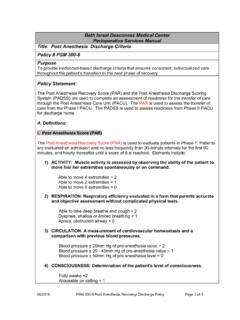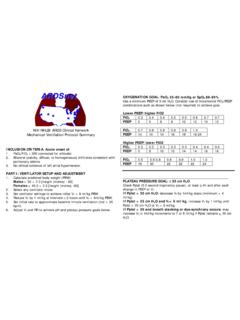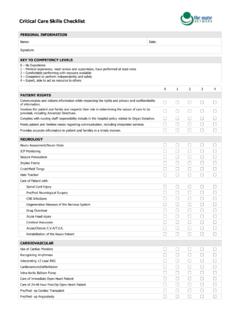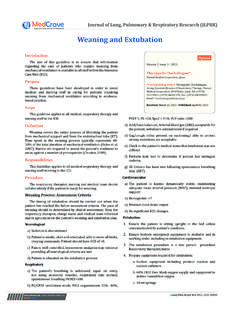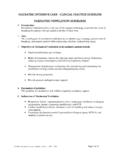Transcription of Ventilator Lecture 1.ppt [Read-Only] - Harvard University
1 Teaching ModuleManoj Dalmia, MD BIDMC Anesthesia Resident The objective of this module is to develop a solid understanding of the different modes of ventilation utilized in the care of surgical patients and other Ventilator -related considerations. By the end of this lesson, the learner should be able to demonstrate and explain the difference between the two most common modes of controlled ventilation: volume control and pressure control. You have a 28 yo female patient who is scheduled to undergo an inguinal hernia repair under general anesthesia. She has a past medical history significant for asthma, snoring (no definitive dx of OSA), GERD, and a recent URI which she said resolved over a week ago. She is 64 inches tall and weighs 110 kg. Her vital signs in the preoperative holding area are as follows: BP 135/87, HR 90, RR 16, and SpO2 99%. Given her body habitus and reflux history, you decide intubating this patient would be the safest way to manage her airway.
2 Would you choose a volume control or pressure control ventilation strategy with this patient? Why?VOLUME CONTROLPRESSURE CONTROL Tidal volume constant Peak airway pressure variable Pressure will increase (to set limit) to maintain tidal volume Tidal volume variable Peak airway pressure constant Tidal volume will increase/decrease if peak pressures decrease/increaseVOLUME-TARGETEDPRESSURE TARGETED Pressure Pressure Pressure Pressure Pressure Pressure Pressure Volume Volume Volume Volume Volume Volume Volume Decreased compliance Increased compliance Pneumothorax Bronchospasm Pleural effusion Increased patient effort Decreased patient effort Adjust the volume under a volume control setting and make note of the change in airway pressures during each mechanical breath Adjust the pressure under a pressure control setting and make note of the change in tidal volumes during each mechanical breath *Observe the differences noted with surgical pressure on the abdomen during the case Which mode of ventilation would be most suitable in our patient?
3 Volume control Obesity decreased compliance Abdominal surgery further decreased compliance/ airway pressures with manipulation of the abdomen Able to maintain constant minute ventilation With pressure control, minute ventilation could be extremely variable *By far, most common mode used in adults Volume control is most common mode of ventilation used in adults Tidal volume constant, pressure variable Pressure control Pressure constant, tidal volume variable Specific instances where it may be preferable over volume control Eg. small children concern for barotrauma (limits peak inflating pressure) plus setting anesthesia ventilators to deliver accurate small tidal volumes is difficult because of the proportionately large compression volume loss in the Ventilator and circuit You re now ready for the next lesson, nice job By the end of this lesson, the learner should be able to demonstrate and explain the difference between the two modes of controlled ventilation most commonly utilized in ICU settings: assist-control (A/C) ventilation and synchronized intermittent mandatory ventilation (SIMV).
4 At the end of the inguinal hernia repair, you notice that the peak airway pressures for your patient begin to rise significantly. In addition, the slope of Phase 2 on the EtCO2 curve begins to increase. You listen to the patient and notice diffuse expiratory wheezes bilaterally. In addition, you notice a diffuse rash and swelling of the patient s face. Her BP drops to 90/40, her HR increases to 110, and her SpO2 drops to 92% with an FiO2 of You become concerned about an anaphylactic reaction but are unsure of the source. Regardless, you correctly make the decision to immediately treat the patient with epinephrine, steroids, and beta-2 agonists. She is transferred to the ICU intubated till her reaction resolves. As her condition improves, she is switched over to assist-control ventilation but you are curious why this is chosen over SIMV. Both control modes of ventilation (either volume or pressure-controlled) Both allow for patient-triggered breaths between minimum programmed mandatory rate Ensures minimum minute ventilation achieved Both modes have their advocates and detractors If the Ventilator senses a spontaneous breath (negative airway pressure)
5 , the Ventilator triggers and delivers a full tidal volume to the patient May adjust sensitivity of trigger Patient determines ventilatory rate though minimum back-up rate set to ensure a minimum minute ventilation *Most commonly used mode of ventilation utilized in ICUs Patients with normal respiratory centers able to auto-regulate respiratory rate May prevent atrophy of ventilatory muscles compared to pure controlled modes of ventilation Decreased work of breathing compared to SIMV Trigger issues If trigger too sensitive, may hyperventilate If trigger not sensitive enough, breathing may become dysynchronous If respiratory center not normal, may be inappropriate to use Each positive-pressure breath intrathoracic pressure and subsequently venous return/CO In those with obstructive airway disease, it may worsen air-trapping and breath-stacking Allows combination of spontaneous, unsupported breathing with a minimum mandatory back-up rate Window of breathing opportunity Time in which a patient may breathe spontaneously If Ventilator does not sense effort during this window , then a positive pressure controlled breath is delivered *Original intent: allow respiratory muscles to rest during controlled breaths and work during spontanous respirations (does not hold true see continued discussion) Spontaneous breathing may improve V/Q matching (Figure 83-8) Negative intrathoracic pressure during spontaneous breaths improves venous return/COEffect of spontaneous ventilation and positive-pressure ventilation on gas distribution in a supine subject.
6 During spontaneous ventilation (A) diaphragmatic action distributes most ventilation to the dependent zones of the lungs, where perfusion is greatest. The result is good matching of ventilation to perfusion. During positive-pressure ventilation (B) because the diaphragm is doing little to no contraction, ventilation is primarily distributed to nondependent lung, increasing the level of ventilation to perfusion mismatch. (Reprinted from Wilkens RL, Stoller JK, Scamlon CC. Egan s Fundamentals of Respiratory Care. 8th ed. St. Louis, MO: Mosby, 2003:972, with permission from Elsevier.)DETRACTORS Work of breathing excessive (see figure) Has been shown that work of breathing not decreased during mandatory breaths as originally thought Delays extubation compared w/ PS and SBT (see Lesson 3) Greater likelihood of dysynchrony versus A/CInspiratory work per unit volume (work per liter [Wp/L]) done by the patient during assisted cycles (open bars) and spontaneous cycles (reverse cross-hatched bars).
7 Wp/L increased with decreasing synchronized intermittent mandatory ventilation percentage for both types of breath. Wp/L for spontaneous breaths tended to exceed Wp/L for machine-assisted breaths. (Marini JJ, Smith TC, Lamb VJ. External work output and force generation during synchronized intermittent mechanical ventilation. Am Rev Respir Dis 1988;138:1169. American Thoracic Society) Both A/C and SIMV are control modes of ventilation that allow for patient triggered breaths Assist control greatest benefit is decreased work of breathing compared to SIMV SIMV greatest benefit is possible improvement in V/Q matching and improved CO compared to A/CYou re now ready for the next lesson, nice job By the end of this lesson, the learner should be able to understand the pressure-support Ventilator mode and its utility in weaning patients from a Ventilator . After a 24-hr period in the ICU, your patient s anaphylactic reaction has resolved. The ICU team would like to wean the patient from the Ventilator and she has done well on assist-control ventilation.
8 As a result, they have placed the patient on pressure-support ventilation with starting settings of FiO2 , PS 10, PEEP 5. Closest mode to trueassist ventilation Lowers work of breathing Requires stable ventilatory drive No trueback-up rate Similar to Pressure A/C butmajor difference is mechanism that terminates inspiration A/C inspiration terminated by time PS inspiration terminated by decreasinggas flow Tracheal flow decreases to ~25% breath terminated Allows patient greatest control over ventilation Patient triggers each breath End of breath based on demand of patient TV varies with each breath, may adjust PS level Weaning is accomplished by decreasing PS level and gradually transferring increased work to patient till PS ~5 extubation typically successful at this Pressure support ventilation is ideal mode for Ventilator wean Lowers work of breathing Allows patient to gradually increase work of breathing as tolerated with eventual goal for extubation Patient triggers each breathYou re now ready for the next lesson, nice job By the end of this lesson.
9 The learner should be able to state the criteria to conduct a spontaneous breathing trial (SBT), what defines failure of a SBT, and which factors may contribute to Ventilator dependence in difficult-to-wean patients. The patient has done extremely well on pressure support ventilation and does not look to be in much respiratory distress. Her current settings are FiO2 of 40%, PS of 5, and PEEP of 0. Her RR is 18. Her ABG results are as follows: Her VS are similar to her preoperative state. The ICU team has decided to initiate a SBT with goal of extubation . Criteria Improvement in factors that led to Ventilator dependence in the first place Assessment of oxygenation PaO2/FiO2 150 mmHg PEEP 8 cm H2O FiO2 pH Hemodynamic stability (low-dose vasopressors OK) Spontaneous (duh!) respirations Patient typically performs SBT for 30-120 minutes and does notmeet any of the following criteria to be considered for extubation : RR > 35 breaths/minute HR > 140 or a sustained of 20% from baseline SBP > 180 mmHg or DBP > 90 mmHg anxiety diaphoresis Other parameters used include.
10 RR < 25 breaths per minute TV > 5 cc/kg VC > 10 cc/kg Negative inspiratory force (NIF) < -25 cmH2O *Rapid shallow breathing index (RSBI) = RR/Vt < 105 Though used in many institutions, has notproven universally successful in identifying those ready to wean*WHEANS NOT Wheezing Heart disease Electrolyte imbalance Anxiety, aspiration, alkalosis Neuromuscular weakness Sepsis, sustained sedation Nutritional deficits Obesity, opioid overdose Thyroid disease*Anesthesiologyby Longnecker, et al There are specific criteria that have been created to determine whether a patient is a candidate for a SBT (though the clinical picture must still be taken into account) NIF and RSBI, though still commonly used, have not been consistently shown to be great predictors of ability to wean Remember the mnemonic WHEANS NOT when considering which patients may be a difficult Ventilator wean! What characteristics does this patient have that may make her a difficult wean?
